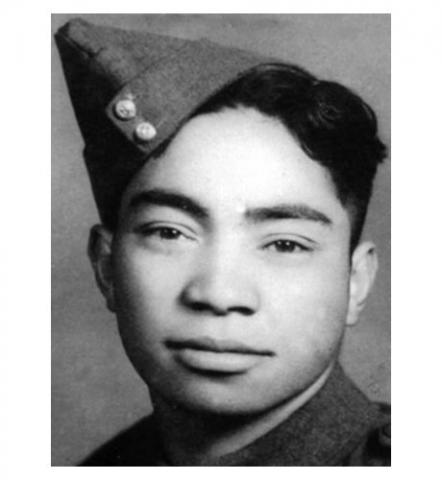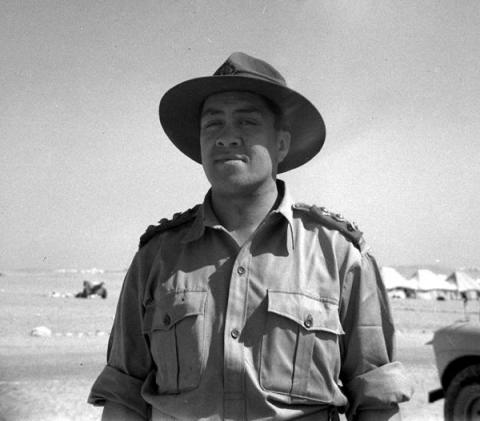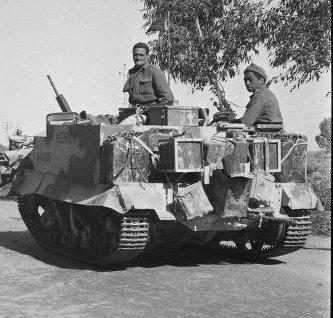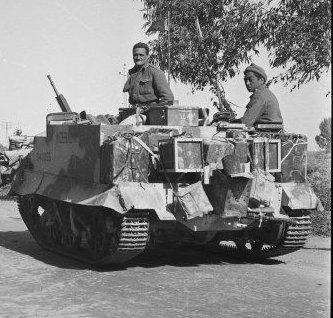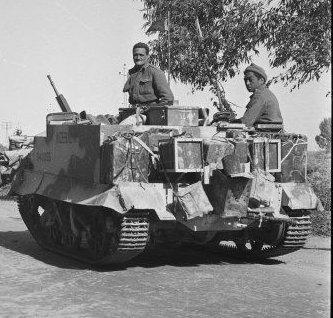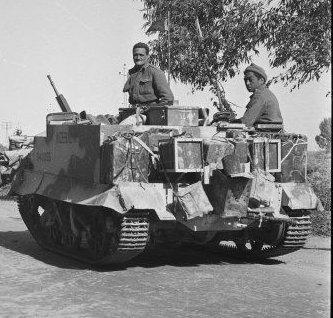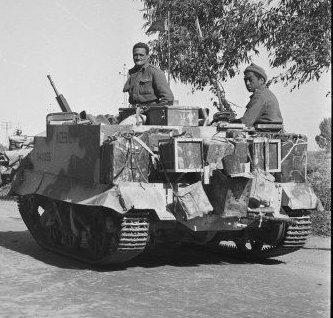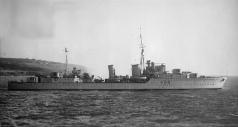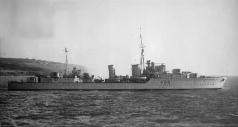<p class="MsoNormal" style="margin: 0cm 0cm 8pt;"><strong>Presentation of the Distinguished Conduct Medal to Private Peter Maangi <span>during the investiture ceremony on 13th of September 1947 at Uepohatu marae. Seventeen decorations were presented to service men and women who had served abroad and on the home front.</span></strong></p><p>The <acronym title=" open space or courtyard where people gather, generally in front of a main building or meeting house; forum of social life; modern meaning: the complex of buildings surrounding the courtyard and the courtyard itself">marae </acronym><em></em>hosted events held on the 12th and 13th of September that included cultural competitions with local school children and the opening of the Uepohatu War Memorial Hall. The hall was built to commemorate East Coast soldiers who died during the two World Wars. A reunion of ex-service people (including members of the Maori Battalion) was also held. </p><p>The gathering was an important one, attended by thousands including the Prime Minister Peter Fraser, the Leader of the Opposition Sidney Holland and other members of Parliament. Sir Bernard Freyberg, the Governor General opened the hall and unveiled two memorial tablets inside.</p>
Media library
Audio
<div class="field-label"><strong>Sound file</strong> from Ngā Taonga Sound & Vision, ref: <a href="https://www.ngataonga.org.nz/collections/catalogue/catalogue-item?recor…;. Any re-use of this audio is a breach of copyright.</div><div class="field-label"> </div><div class="field-label"><strong>Image </strong>Nga Taonga a Nga Tama Toa Trust</div>
<p class="MsoNormal" style="margin: 0cm 0cm 8pt;"><strong>Presentation of the Military Cross to Reverend Wi Te Tau Huata <span>during the investiture ceremony on 13th of September 1947 at Uepohatu marae. Seventeen decorations were presented to service men and women who had served abroad and on the home front.</span></strong></p><p>The <acronym title=" open space or courtyard where people gather, generally in front of a main building or meeting house; forum of social life; modern meaning: the complex of buildings surrounding the courtyard and the courtyard itself">marae </acronym><em></em>hosted events held on the 12th and 13th of September that included cultural competitions with local school children and the opening of the Uepohatu War Memorial Hall. The hall was built to commemorate East Coast soldiers who died during the two World Wars. A reunion of ex-service people (including members of the Maori Battalion) was also held. </p><p>The gathering was an important one, attended by thousands including the Prime Minister Peter Fraser, the Leader of the Opposition Sidney Holland and other members of Parliament. Sir Bernard Freyberg, the Governor General opened the hall and unveiled two memorial tablets inside.</p><p class="MsoNormal" style="margin: 0cm 0cm 8pt;"><strong><span></span></strong> </p>
<p><strong>Sound file</strong> from Ngā Taonga Sound & Vision, ref: <a href="https://www.ngataonga.org.nz/collections/catalogue/catalogue-item?recor…;. Any re-use of this audio is a breach of copyright.</p><p><strong>Image </strong>Bull, George Robert, 1910-1996. Bull, George Robert: Captain Reverend Wi Te Tau Huata in Egypt during World War II. New Zealand. Department of Internal Affairs. War History Branch :Photographs relating to World War 1914-1918, World War 1939-1945, occupation of Japan, Korean War, and Malayan Emergency. Ref: DA-04461-F. Alexander Turnbull Library, Wellington, New Zealand. <a href="http://natlib.govt.nz/records/22763913">http://natlib.govt.nz/records/2…;
<p><strong>Te Tohara (Charlie) Mohi grew up in Pakipaki. He embarked for war in 1941 and served with the Maori Bren-carrier platoon. </strong><strong>Charlie returned on furlough in 1945, see the photo <a href="/node/22923">here</a>.</strong></p><p><strong>After leaving New Zealand the Reinforcements docked at Freemantle for a short while.<br /></strong></p><h2><strong>Transcript<br /></strong></h2><p><strong>Te Tohara Mohi: </strong>Engari te taenga atu ahua tata atu matou ki Ahitereiria ra, ko au tetahi ano te, o te, o nga Kaari o te o te tima, ta matou mahi e whakatutu haere i a matou to matou Apiha, e kore e maungia atu he pia ki waho, e tama, i aua wa ra kua pia katoa nga wa, nga tima. </p><p>To matou taenga atu ki a Freemantle, ki Perth. Tae atu matou ki Freemantle, a, kare matou e tukua kia haere ki runga i te whenua haere, oh, ki roto i te taone. Te mataku o nga, o matou apiha, kei puta atu matou kare hoki e whakaengia nga Ahitereiria kia haere atu ki te whenua ra. No te mea ko tera te tuatahi o nga raupatutanga i a ratou, o nga hoia o tera taha. A, ka tuku atu a ratou kia hoki atu ki to ratou whenua, hei, ngaro to reo. A, koa oti ta matou mahi i reira ka tae mai nga tima o, o tahaki, mau mai ngia a nga kai mo to matou waka, mo to matou tima, a, nga mea toa o matou kua heke atu ki runga i nga, ki nga tima paku, a hoki atu ki te, ki te taone, ki reira karia ka haere. Mahi porangi, haurangi noa, a, ka karangahia matou kia haere ki te tiki, ah well, to matou taenga atu ki reira, ka ngaro ano hoki matou.</p><p>Koinei nga mahi tinihanga, nga mahi a te hoia, to matou hoki mai tanga ki, ki runga i to matou waka, ah well, ka karanga mai ngia e Bully Jackson, “Haramai Mohi.” I said, “He aha tena Bully?” “Kia tangongia atu te mea nei.” A, ko Bully hoki to matou apiha, a ko Bully ae, he Apiha pai.</p><p><strong>Pou Temara: </strong>Ana, ka tangohia atu nga stripes.</p><p>A, ka tangongia atu. E rua, toru, iwa kare tahi hoki he Heihana naku i timata ka homaingia ano.</p>
<p><strong>Sound file</strong> from Ngā Taonga Sound & Vision, ref: <a href="https://www.ngataonga.org.nz/collections/catalogue/catalogue-item?recor…;. Any re-use of this audio is a breach of copyright.</p><p><strong>Image<br /></strong>Crop of <a href="/node/3856" target="_blank">full photo</a> - Bren-carrier platoon leads the Maori Battalion into Tripoli, 23 January 1943. Sgt Te Whiu Purei (standing) and Charlie Mohi, seated.</p>
<p><strong>Te Tohara (Charlie) Mohi grew up in Pakipaki. He embarked for war in 1941 and served with the Maori Bren-carrier platoon. </strong><strong>Charlie returned on furlough in 1945, see the photo <a href="/node/22923">here</a>.</strong></p><p><strong>Here, Charlie talks about the hard and bad things about war, such as the deaths of his comrades.</strong></p><h2><strong>Transcript</strong></h2><p><strong>Te Tohara Mohi: </strong>Te mea kino ki au o te whawhai, ka titiro koe, a, kei whea o hoa? Ko nui te aroha ki to hoa, a, kua ngaro! Tetahi hoa, tino hoa noku, no te kainga nei, no, no to matou kainga. Mai rano i a maua e tamariki ana. A, e haere ano maua i te whawhai, a, taku kitenga i a ia i whara i te, i te bomb. Kua tata ke, kua pora ke ngia te ringa, hei pupuri ana tona ringa. Meingia atu ki runga i te ambulance, a ka korero mai ki au, “Maku e whanga mai i te kainga”. That’s him, ringi atu ki a matou – kua mate ke. Engari tera tangata kare au i rongo tetahi tangata kae mo te play piano. Ko Charlie Kunz tonu, ka purei mai e ia a Charlie Kunz’s i te record, kei kona ia – rite tonu! A, ki toku whakaaro, mohio tonu a ia ka makere tona, ka poroa tona ringa, ka mate tonu atu. Kare ke e pai ki a ia. </p><p><strong><br /></strong></p><p><strong><br /></strong></p>
<p><strong>Sound file</strong> from Ngā Taonga Sound & Vision, ref: <a href="https://www.ngataonga.org.nz/collections/catalogue/catalogue-item?recor…;. Any re-use of this audio is a breach of copyright.</p><p><strong>Image<br /></strong>Crop of <a href="/node/3856" target="_blank">full photo</a> - Bren-carrier platoon leads the Maori Battalion into Tripoli, 23 January 1943. Sgt Te Whiu Purei (standing) and Charlie Mohi, seated.</p>
<p><strong>Te Tohara (Charlie) Mohi grew up in Pakipaki. He embarked for war in 1941 and served with the Maori Bren-carrier platoon. </strong><strong>Charlie returned on furlough in 1945, see the photo <a href="/node/22923">here</a>.</strong></p><p><strong>Charlie recounts a hilarious story about one young soldier's particular expression of comradery, giving his friends black-eyes.<br /></strong></p><h2><strong>Transript</strong></h2><p><strong>Te Tohara Mohi: </strong>Engari he nui tonu ratou, you know, o hoa, tino hoa nei. I roto ke au i a C Company, e, pai rawa atu to matou, taku, aku rangatira ki au. Hei a ia ratou, e tama, nga mahi katoa kei taua iwi ra.</p><p><strong>Pou Temara: </strong>Tena kōrerohia mai.</p><p><strong>Te Tohara Mohi: </strong>I tetahi kirihimete, to matou kirihimete tuatahi, kei roto tonu matou i Maadi. A, ka tae mai taku tuakana. I taua taima ra he heihana ia, he corporal noa iho au. Ka haere matou, katahi he moni, titiro haere matou, to matou platoon katoa. Katahi he moni – a ka haere matou ki te purei Housie Housie. Ka whiwhi tetahi House, e rua tekau pauna ke te utu o tena house – oh a ka nui tena. Matou katoa, karawhiungia atu ki tana awhi. Hokohoko mai ngia a matou pia ki runga I to matou tepu. Ka timata matou te kai pia, ka puta mai e rua o matou, a, haria aua tokorua nei, ko ratou tonu nga mea tamariki o to matou roopu. Ka haere atu tetahi ki tona hoa, tino hoa rawa atu nei. Kei te unu, a, “good luck”. Ka unu tahau pounamu. Ka meinga atu ta raua pounamu ki raro ka mea mai te mea paku o raua, “Merry Christmas”. Meke tonu ia tana konohi tonu. Merry Christmas dear– bang! Ooo, kua timata te whaiwhai. “A, e noho, e noho.” Kei te karanga te mea paku, “Hey, katahi oku present mahau, ko tera ano taku present mahau.” Bang. Ana, homangia taku present ka karawhiua mai ngia tena, mai I tena wa e hoa, kua whiwhi presents katoa matou. Ka haere atu koe ki to hoa, ka karanga atu “Merry Christmas” – bang! Kua pupuhi ke nga whatu, ooo e hoa, ko au noa iho. Te kitetanga pera te mahi a matou hoa, aku hoa, auuuu, ka hoki au. Ka haere au i te mohititanga o taku tuakana. I te ata, ka rongo korero, kua pango katoa nga kanohi o aku hoa. Taku korero pera tonu ki taku tuakana, “A i oma mai au, e tama, kei te porangi te iwi ra.” E karanga mai e tetahi au i waho - Poipoi, e, Poipoi Kohere, “E Mohi, hurry up, we’re on Church parade!” Puta atu taku mahunga, boom (slap sound, laugh). E to matou minita, to matou apiha… a, ei, no Tokomaru ra. E tama, pango katoa, haere matou i te parade, Church Parade, kei konei katoa. To matou minita i taua taima ko Rangi, and kua rongo ke a Rangi a matou mahi, kei te korero mai kia matou i roto i tona kauhau, “Kei te pai te aroha o tetahi, o etahi o tatou, kei te mau tonu o ratou whakaaro aroha i roto i nga kanohi.” E tama, koinei nga mea, you know, nga mea koakoa.</p><p><strong>Pou Temara:</strong> Ka pai hoki nga perehana.</p><p><strong>Te Tohara Mohi:</strong> E toru tekau ma toru matou, toru tekau ma rua – pango katoa! </p>
<p><strong>Sound file</strong> from Ngā Taonga Sound & Vision, ref: <a href="https://www.ngataonga.org.nz/collections/catalogue/catalogue-item?recor…;. Any re-use of this audio is a breach of copyright.</p><p><strong>Image<br /></strong>Crop of <a href="/node/3856" target="_blank">full photo</a> - Bren-carrier platoon leads the Maori Battalion into Tripoli, 23 January 1943. Sgt Te Whiu Purei (standing) and Charlie Mohi, seated.</p>
<p><strong>Te Tohara (Charlie) Mohi grew up in Pakipaki. He embarked for war in 1941 and served with the Maori Bren-carrier platoon. </strong><strong>Charlie returned on furlough in 1945, see the photo <a href="/node/22923">here</a>.</strong></p><p><strong>In this recording Charlie recounts a particular engagement in the desert between the Battalion and Germans.</strong></p><p><strong>Site editors note: ? - denotes audio is indecipherable</strong></p><h2><strong>Transcript</strong></h2><p>Kei te moe ke au i te taha o taku, taku waka, he moe ngenge tonu nei. Ka maharahara oku hoa kua whara au. Ka haramai taku heihana ki te tiro i a ia, e kei te ngongoro ke te ?. Kare i o ngongoro o te toa nei, he ngongoro, he ngongoro mangere Bear au. Ka haere mai matou, a ka mauria matou ki runga tetahi ahua hiwi nei. Ko nga hoia o nga, o matou hoia, kua karikari katoa i o ratou trenches kei mua tonu i a matou, e whanga ana mo te Tiamana. Kite matou e hara mai ana nga Tiamana kei runga hiwi ke matou e titiro ana. Ka haramai nga Tiamana ra, a, e rimu tekau iari pea te tawhiti mai ki o matou. Ka heke ratou. Kei te haere atu hoki o matou, a matou pu, e kei te haramai tonu te Tiamana nei. Ka kite matou, te tera te tuatahi i kite ana au te Tiamana e mea ana i te peita. Kuhungia atu te pene ki mua i to ratou reiwhara ka hara mai ratou. Kei te whakaaro, he aha hoki te mahi a matou tamariki, a matou hoia, kei te tuhi, kei te paku nga pu, engari kei te hara mai tonu te Tiamana. Ka ahua tata mai pea, e rua tekau iari i pea ka timata te haka. Rongo tonu ma te, e rua rau iari pea matou i muri. Kei te rongo matou, i a matou mea, a matou tangata e haka ana. E, ka piki atu i waho. Ka haere tonu atu me a ratou peneti. Timata to matou, te huritanga o tera te Tiamana – araaaaa. A hoki, ka whai haere tonu, whai haere tonu, kei te rongo matou e karanga ana nga apiha, nga heihana “kia hoki mai, kia hoki mai.” A, hoki mai ratou. Kua ahua tata tonu te pouri i taua wa. Well, kua puta mai nga korero ko, ko te mea kua ‘circlengia’ matou. Ei, me pewhea hoki! Ah well, kei te haere tonu tena i tona taha, haere tonu. Tena. Ka puta mai o matou apiha, me nga korero. “Kei te haere matou, e moe, engari kei te haere tatou i te rua o nga haora i te ata. Kua huri noa te Tiamana kei waenganui tatou.” Kua maungia to tatou rangatira a Freyberg, i whara i taua wa. Kua maungia, kua puta ma runga aeroplane. Engari tatou, well, a te rua o nga haora ka whawhai tatou, kokiritia tatou kia puta atu.<strong> <br /></strong></p>
<p><strong>Sound file</strong> from Ngā Taonga Sound & Vision, ref: <a href="https://www.ngataonga.org.nz/collections/catalogue/catalogue-item?recor…;. Any re-use of this audio is a breach of copyright.</p><p><strong>Image<br /></strong>Crop of <a href="/node/3856" target="_blank">full photo</a> - Bren-carrier platoon leads the Maori Battalion into Tripoli, 23 January 1943. Sgt Te Whiu Purei (standing) and Charlie Mohi, seated.</p>
<p><strong>Te Tohara (Charlie) Mohi grew up in Pakipaki. He embarked for war in 1941 and served with the Maori Bren-carrier platoon. </strong><strong>Charlie returned on furlough in 1945, see the photo <a href="/node/22923">here</a>.</strong></p><p><strong>Charlie discusses the importance of gambling during downtime in Egypt and being the 'bank' for his comrade's winnings.</strong></p><p><strong>Site editors note: ? - indicates audio is indecipherable.<br /></strong></p><h2><strong>Transcript</strong></h2><p><strong>Te Tohara Mohi: </strong>Engari te mahi ia matou i Ihipa, te mahi gambling. Tekau ma rua marama ke matou i roto i te, te desert e haere ana. Kare taea he toa, kare taea he wahi hei hoko, hoko kai aha ranei. Te ngahau a nga mea pirangi tena mahi. He mea i Tsing Tai Lu, nga dices. Taku hoa, tino hoa i taua taima, ko Billy Maha. Oh tera tangata mo te gamble, aue e tama. Na na tera mahi, tona toa tonu i taua mahi. I tetahi wa ko au tonu wana peke, maku e manaaki ona moni. Ka hara mai, ka maungia mai ana moni ki au. Ka kuhungia atu au ki roto i taku peke. Engari me mahi huna nei, me whanakohia hoki.</p><p><strong>Pou Temara (interviewer)</strong>: ?</p><p><strong>Te Tohara Mohi: </strong>Ia matou I hoki mai i te pakanga, e toru ke aku peke. Kotahi me te hawhe, kii tonu i te moni, nga moni a taku hoa. Kare au e mohio how much – e hia nga moni ra. To matou taenga mai, kotahi noa iho tana ka tae mai matou ki te kainga nei, e tama kua whanakotia. Ohhh tino mamae ra atu au nga mahi whanakotanga, nga moni a taku hoa. </p><p><strong><br /></strong></p>
<p><strong>Sound file</strong> from Ngā Taonga Sound & Vision, ref: <a href="https://www.ngataonga.org.nz/collections/catalogue/catalogue-item?recor…;. Any re-use of this audio is a breach of copyright.</p><p><strong>Image<br /></strong>Crop of <a href="/node/3856" target="_blank">full photo</a> - Bren-carrier platoon leads the Maori Battalion into Tripoli, 23 January 1943. Sgt Te Whiu Purei (standing) and Charlie Mohi, seated.</p>
<p> </p><p> </p><p class="MsoNormal"><strong>Te Tohara (Charlie) Mohi grew up in Pakipaki. He embarked for war in 1941 and served with the Maori Bren-carrier platoon. <br /></strong></p><p class="MsoNormal"><strong>In this final recording, Charlie recounts the first time he saw his wife and his warning to his comrades that they were to stay away from her. </strong></p><p class="MsoNormal"><strong>Charlie finishes his interview with an acknowledgement of his comrades who died in the war and those who returned who had also passed on.<br /></strong></p><h2>Transcript</h2><p>Taku taenga mai, i te po i tae mai e au, ka kite au i taku hoa wahine (kata). Ka korero atu au ki aku hoa, “Ka kite koe tera – naku. Kaua koutou, kaua koutou e whakatata atu ki tera, naku tera.”<br />“A, ko wai hoki te ingoa?”<br />“E, kare hoki e mohio, maku e kite e korero atu au.”<br />A, whakaaro pai tonu mai aku hoa kua waihongia taku, taua kotiro nei maku. A, engari ko nga ahua i riro mai ki au, ei, ahua pai tonu. Ka karanga atu au ki te kotiro, “Haere mai, kei te haere koe i taku kainga ki te kai.”<br />“Kare rawa atu, kare e mohio i a koe!”<br />“Kei te pai, haere koe ki te kainga ka mohio koe i a au.”<br /><br />Mai ra ano ki tera wa ki tenei wa, ko taku hoa wahine tenei. Engari ko nga korero, ki au inaianei ko nga mea whakakatakata noa iho. Kei reira ano nga mea kino, engari koira, ki oku whakaaro inaianei kua tapu. Ki nga mate o aku hoa, ki a ratou ma i hingahinga mai i reira. Ka hoki tonu nga whakaaro i etahi wa ki a ratou, engari ko nga mea ngahau kei te mau tonu. Kei te mau tonu era, engari waihongia. No reira, akuni pea me mutu nga korero o tenei. Ko aku hoa, i hoki mai ai matou nga mea o Ngati Porou, te nuinga o ratou kua matemate katoa. Katahi tonu i tera tau ra, etahi o ratou, koinei nga tino hoa i mohio ai au i te wa o te pakanga. A, me waiho i reira, kia ora tatou. </p>
<p><strong>Sound file</strong> from Ngā Taonga Sound & Vision, ref: <a href="https://www.ngataonga.org.nz/collections/catalogue/catalogue-item?recor…;. Any re-use of this audio is a breach of copyright.</p><p><strong>Image<br /></strong>Crop of <a href="/node/3856" target="_blank">full photo</a> - Bren-carrier platoon leads the Maori Battalion into Tripoli, 23 January 1943. Sgt Te Whiu Purei (standing) and Charlie Mohi, seated.<br /><br />Paton, Harold Gear, 1919-2010. Maori Battalion, with anti-tank gunners and a Bren carrier, on an Italian Road leading into Tripoli, during World War 2 - Photograph taken by H Paton. New Zealand. Department of Internal Affairs. War History Branch :Photographs relating to World War 1914-1918, World War 1939-1945, occupation of Japan, Korean War, and Malayan Emergency. Ref: DA-02871-F. Alexander Turnbull Library, Wellington, New Zealand. <a href="https://natlib.govt.nz/records/23069449">https://natlib.govt.nz/records… />See the full photo <a href="/node/3856">here</a>.</p>
<p><strong>Major Tiwi Love speaks on behalf of the 28th Māori Battalion at the launch of the HMS <em>Maori.</em></strong></p><p><strong>Major Love: </strong>Commander Jonas, Ships Company, ladies and fellow officers, other ranks of the 28th Māori Battalion. I’m very sorry indeed that our Colonel has not been able to come down and accept this emblem on behalf of the 28th Māori Battalion but he has delegated me to accept the same on behalf of our Battalion. He assures me that as soon as we are able to get back to the Battalion again it will be presented at a full ceremonial parade of the Battalion, wherein, whereat we hope that some member or members of the HMS Maori will be present. We the 28th Māori Battalion, members of the 28th Māori Battalion, and I’m sure other members of the New Zealand Expeditionary Forces, including our nursing service who have come on this ship today, feel very highly honoured and we feel that we have at last put our foot again on New Zealand after being away so long. On behalf of our Colonel and the officers, Warrant officers and other ranks of the 28th Māori Battalion – I thank you Sir. Before concluding Sir, we feel that we are bound on account of our foulings around in the Libyan Desert, we have one or two souvenirs, the 28th Maori Battalion seem to be well known for souvenirs, and on the occasion of the 26th of November (1941), Rommell unfortunately was able to get out of Halfaya Pass, but he came up against B Company of the 28th Māori Battalion who captured one of his staff cars and in it were a lot of these flags. We hope that you will accept this from the 28th Battalion as one of the souvenirs of war.</p><p><strong></strong>(Well done the Māoris)</p>
<p><strong>Sound file</strong> from <a href="https://www.ngataonga.org.nz">Ngā Taonga Sound & Vision</a>. Any re-use of this audio is a breach of copyright.</p><p><strong>Photo: </strong><a href="http://en.wikipedia.org/wiki/File:HMS_Maori_%28F24%29.jpg">Destroyer HMS Maori (F24) underway, coastal waters</a>.<br /><strong>Date:</strong> 18 March 1939<br /><strong>Source</strong>: <a href="http://www.iwm.org.uk/">Imperial War Museums</a>, FL 15085 (collection no. 8308-29[1]) <br /><strong>Author</strong>: Royal Navy official photographer</p>
<p><strong>Representatives of the Māori Battalion were received on board the HMS <em>Maori</em> as guests of the commander and his men. Māori achievements in Greece, Crete and Libya were marked by the presentation of the HMS <em>Maori's</em> ensign complete with the ship's talisman - a tiki. Māori Battalion members present include Major Tiwi Love, Major Doug Harvey, Lieutenants’ Piiti Wordley, Taipa. Privates’ Aubrey Rota, Ropiha Korau, Edwards [?], Barrett [?], Rangi [?], Wharerau, Kurepo [?], Kelly Hawira, Tuhimareikura Manawaroa, Pene, Johnson, Hau, Robinson [?], Paraini [?]</strong>, <strong>Katae, Te Kani, Te Tana, Warbrick and Hoia [?]</strong><br /><br /><strong>Major Rangi Royal thanks the hosts for the honour and his speech ends with a performance by the Battalion party of the famous haka “Ka mate”. </strong><br /><br /><strong>Major Rangi Royal: </strong>Commander Jonas, the Ships Company, ladies, members of the medical staff of No. 3 Annex General hospital, officers, and NCOs and other ranks of the Māori Battalion. I would ask your indulgence just for a few minutes. On occasions like this we have a custom we must observe and I intend at this stage to say just a few words to your good ship.<br /><br />Te waka e tau nei e, tēnā koe. Tēnā koe kua whakawahia nei ki te ingoa e mau nei hei ingoa o te iwi Māori. Tēnā koe i puta mai i te mura o te ahi, a, e tau nei. Mā Tangaroa koe e manaaki. Mā te Atua koutou katoa e manaaki. Te Moananui a Kiwa e takoto nei, tēnā koe. Tēnā koe e manaaki haere nei i te ingoa o to iwi. Nāu e manaaki, a, tae noa te tutukitanga o tēnei pakanga, tēnā koe. <br /><br />Commander Jonas I think this is really an occasion of historical interest. When the Māori khaki clad meets the Māori iron clad. They meet today and the khaki clad is welcomed by the iron clad as your hospitality has shown today. We are indeed very much honoured by your invitation and I say as representative of the race, that the race is honoured also by the fact that one of its most noted destroyers bears the name of the race. We hope that the hosts of Tangaroa will always attend you, that Kiwa who commands the great oceans will always smile upon you and that God Almighty will guide and protect you and all of us so that we may attain that goal the world desires - victory, peace and joy for all. I thank you.<br /><br /><strong>28th Māori Battalion members:</strong><br />Ka mate, ka mate! Ka ora ka ora!<br />Ka mate, ka mate! Ka ora ka ora<br />!Tēnei te tangata puhuruhuru nānā i tiki mai whakawhiti te ra<br />Ā hupane, a hupane, a hupane kaupane whiti te ra</p>
<p><strong>Sound file</strong> from Ngā Taonga Sound & Vision, ref: <a href="https://www.ngataonga.org.nz/collections/catalogue/catalogue-item?recor…;. Any re-use of this audio is a breach of copyright.</p><p><strong>Photo: </strong><a href="http://en.wikipedia.org/wiki/File:HMS_Maori_%28F24%29.jpg">Destroyer HMS Maori (F24) underway, coastal waters</a>.<br /><strong>Date:</strong> 18 March 1939<br /><strong>Source</strong>: <a href="http://www.iwm.org.uk/">Imperial War Museums</a>, FL 15085 (collection no. 8308-29[1]) <br /><strong>Author</strong>: Royal Navy official photographer</p>
<p><strong>During a Christmas Day broadcast from the Middle East in 1943 the Battalion sing 'Te ope tuatahi". </strong><strong></strong></p><p><strong>After being inspired by the Battalion's efforts at Gallipoli Sir Apirana Ngata composed the song. It was also a means to inspire recruitment for the war effort. During</strong><strong> World War I Maori recruitment (as well as Pakeha) had waned. </strong><strong></strong><strong> </strong><strong> </strong><strong></strong><strong> </strong><strong> <br /></strong><strong><br /></strong>Listen to <a href="http://www.28maoribattalion.org.nz/node/13753" target="_blank">another version</a> of the song sung by school girls in Gisborne in 1940.</p>
<p><strong>Sound file</strong> from Ngā Taonga Sound & Vision, ref: <a href="https://www.ngataonga.org.nz/collections/catalogue/catalogue-item?recor…;. Any re-use of this audio is a breach of copyright.</p>
<p>This recording taken in 1942 is of a group of Māori patients from No. 2 New Zealand General Hospital in North Africa. </p><p>Nurse Wiki Katene of Porirua (Ngāti Toa)and a group of patients from the Māori Battalion sing “Tama Ngākau Mārie”. Wiki introduces the young men who offer greetings in Māori to different iwi, hapū and localities. Some of the voices are hard to decipher, but the following soldiers, all wounded during the Alamein Campaign, have been identified:</p><ul><li>Wiremu Pohe, Ngapuhi - Whangarei</li><li>Ngaone Tahere, Kaikohe - Ngati Tautahi</li><li>(?), Te Arawa - Ngati Pikiao</li><li>Pena Hohepa, Matata</li><li>Pita Hodge, Ngati Whakaue - Ohinemutu</li><li>Te Irimana (Paul) Waenga, Te Whānau-a-Apanui</li><li>(?) McClutchie, Ngati Porou - Wharekahika</li><li>Barney Kapuaroa, Turanganui</li><li>Possibly Richard Hale:Hauraki - Harataunga (Kennedy Bay)</li><li>Unidentified possibly Wharau or Heremia Houkamau(?) sends greetings on behalf of himself and Tame Makarati (aka Huna McClutchie) - Wharekahika (Hicks Bay)</li><li>Tame (Thomas) Karena, Ngati Kahungunu - Wairoa, Heretaunga</li><li>Kopu Heremia, Ngati Raukawa - Ohau</li><li>Lt. Sgt. Hira Parata, Ngati Toa - Porirua, Whakarongotai - Waikanae</li><li>Cpl Ripene Matoe, Ngati Ruanui</li><li>Hami (Hamuera) Ngaheke, Ngati Pikiahu-Waewae - Kakariki, Tokorangi</li></ul>
<p><strong>Sound file</strong> from Ngā Taonga Sound & Vision, ref: <a href="https://www.ngataonga.org.nz/collections/catalogue/catalogue-item?recor…;. Any re-use of this audio is a breach of copyright.</p>

